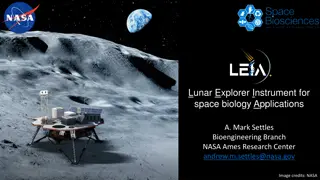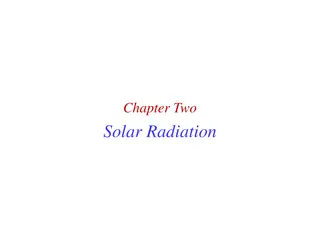Exploring the Solar System: Light, Radiation, and Wave Properties
Delve into the fascinating realm of astronomy by understanding the significance of light and other forms of radiation in investigating celestial bodies. Explore the properties of light waves, wavelengths, colors, and their role in uncovering mysteries across the vast expanse of the cosmos.
Download Presentation

Please find below an Image/Link to download the presentation.
The content on the website is provided AS IS for your information and personal use only. It may not be sold, licensed, or shared on other websites without obtaining consent from the author.If you encounter any issues during the download, it is possible that the publisher has removed the file from their server.
You are allowed to download the files provided on this website for personal or commercial use, subject to the condition that they are used lawfully. All files are the property of their respective owners.
The content on the website is provided AS IS for your information and personal use only. It may not be sold, licensed, or shared on other websites without obtaining consent from the author.
E N D
Presentation Transcript
ASTR 2320 General Astronomy II Professor Mike Brotherton Chapter 4 Overview of the solar system
Dobsons long chapter 4 plows Nineplanets.org. https://solarsystem.nasa.gov/ Traditional eight planets, dwarf planets, asteroids, comets, moons, etc. Some interesting facts and physics about many. Video about asteroid sizes: https://www.youtube.com/watch?v=bSkPNMjRRio&feature=emb_logo Infographic about moon sizes: https://astronomy.com/news/observe-the-solar-system/2017/02/how- big-is-the-biggest- moon?utm_source=asyfb&utm_medium=social&utm_campaign=asyfb&fbclid=IwAR0CIdtxUwMoFtZY K1_L7Zy_uwC2Wrukz2kQLUGRpvdjVI3-9kZcXDFQfXY
Light and Other Forms of Radiation The Electromagnetic Spectrum In astronomy, we cannot perform experiments with our objects (stars, galaxies, ). The only way to investigate them is by analyzing the light (and other radiation) which we observe from them.
Light as a Wave c = 300,000 km/s = 3*108 m/s Light waves are characterized by a wavelength and a frequency f. f and are related through f = c/
Wavelengths and Colors Different colors of visible light correspond to different wavelengths.
Dark Side of the Moon Dark Side of the Moon There is no dark side really. It s all dark. -- Pink Floyd
Dark Side of the Moon Dark Side of the Moon What is wrong with this picture? Front: Not all primary colors (eg, pink, magenta), also refraction angles inconsistent Back: Spectrum is Convergent I think done for art s sake Front cover Back cover More accurate, from Richard Berg
Light as a Wave Wavelengths of light are measured in units of nanometers (nm) or angstrom ( ): 1 nm = 10-9 m 1 = 10-10 m = 0.1 nm Visible light has wavelengths between 4000 and 7000 (= 400 700 nm).
The Electromagnetic Spectrum Wavelength Frequency High flying air planes or satellites Need satellites to observe
Light as Particles Light can also appear as particles, called photons (explains, e.g., photoelectric effect). A photon has a specific energy E, proportional to the frequency f: E = h*f h = 6.626x10-34 J*s is the Planck constant. The energy of a photon does not depend on the intensity of the light!!!
Temperature and Heat Temperature and Heat Thermal energy is kinetic energy of moving atoms and molecules Hot material energy has more energy available which can be used for Chemical reactions Nuclear reactions (at very high temperature) Escape of gasses from planetary atmospheres Creation of light Collision bumps electron up to higher energy orbit It emits extra energy as light when it drops back down to lower energy orbit (Reverse can happen in absorption of light)
Temperature Scales Temperature Scales Want temperature scale with energy proportional to T Celsius scale is arbitrary (Fahrenheit even more so) 0o C = freezing point of water 100o C = boiling point of water By experiment, available energy = 0 at Absolute Zero = 273oC (- 459.7oF) Define Kelvin scale with same step size as Celsius, but 0K = -273oC = Absolute Zero Use Kelvin Scale for most astronomy work Available energy is proportional to T, making equations simple (really! OK, simpler) 273K = freezing point of water 373K = boiling point of water 300K approximately room temperature
Planck Black Body Radiation Planck Black Body Radiation Hot objects glow (emit light) as seen in PREDATOR, etc. Heat (and collisions) in material causes electrons to jump to high energy orbits, and as electrons drop back down, some of energy is emitted as light. Reason for name Black Body Radiation In a solid body the close packing of the atoms means than the electron orbits are complicated, and virtually all energy orbits are allowed. So all wavelengths of light can be emitted or absorbed. A black material is one which readily absorbs all wavelengths of light. These turn out to be the same materials which also readily emit all wavelengths when hot. The hotter the material the more energy it emits as light As you heat up a filament or branding iron, it glows brighter and brighter The hotter the material the more readily it emits high energy (blue) photons As you heat up a filament or branding iron, it first glows dull red, then bright red, then orange, then if you continue, yellow, and eventually blue
Planck and other Formulae Planck and other Formulae Planck formula gives intensity of light at each wavelength It is complicated. https://en.wikipedia.org/wiki/Planck%27s_law We ll use two simpler formulae which can be derived from it. Wien s law tells us what wavelength has maximum intensity Stefan-Boltzmann law tells us total radiated energy per unit area From our text: Horizons, by Seeds
Example of Wiens law Example of Wien s law What is wavelength at which you glow? Room T = 300 K so This wavelength is about 20 times longer than what your eye can see. Thermal camera operates at 7-14 m. What is temperature of the sun which has maximum intensity at roughly 0.5 m? From our text: Horizons, by Seeds
What is this a spectrum of? Spectra of astrophysical objects are usually combinations of these three basic types.
Planetary temperatures Nice overview at wiki: https://en.wikipedia.org/wiki/Black- body_radiation and also https://en.wikipedia.org/wiki/Planetary_equilibrium_temperature Modifications necessary depending on phase locking or rapid rotation More modifications based on greenhouse effect: https://en.wikipedia.org/wiki/Greenhouse_effect























